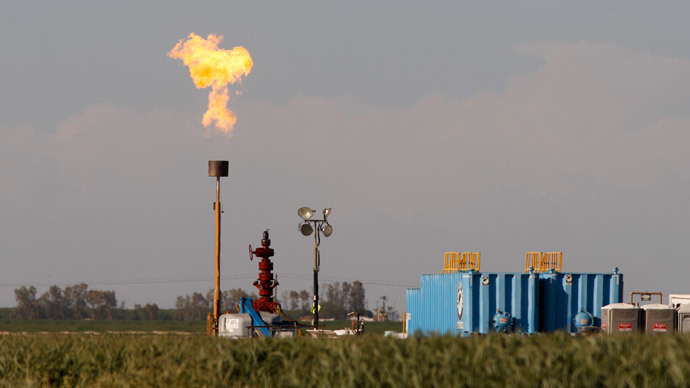Methane emissions from fracking vastly underestimated by EPA - study
Le emissioni di metano dalle operazioni di fracking sono state enormemente sottostimate dall'EPA - studio
The Environmental Protection Agency is under fire for underestimating the amount of methane gas emitted during natural gas operations, including fracking, thanks to a new study published in the Proceedings of the National Academy of Sciences (PNAS).
Grazie a un nuovo studio dell'Accademia nazionale delle Scienze l'Agenzia per la protezione dell'Ambiente è sotto attacco per aver sottostimato le quantità di metano emesse durante le operazioni relative al gas naturale, fracking incluso
The study has 13 co-authors from several academic and research institutions, and used an aircraft to identify large sources of methane and quantify emission rates in southwestern Pennsylvania in June 2012. The authors discovered that emissions rates per second were 1,000 times higher than those estimated by the EPA for the same time period.
Lo studio conta con 13 co-autori provenienti da istituti accademici e di ricerca, e hanno usato un velivolo per identificare le fonti importanti di metano e quantificare le portate delle emissioni riferite al secondo trovando che queste erano 1000 volte più alte di quelle stimate dall'EPA per lo stesso periodo.
“Methane is the second most prevalent greenhouse gas emitted in the United States from human activities,” the EPA website states. Carbon dioxide is the most prevalent, but it is not as damaging of a greenhouse gas as methane. “Pound for pound, the comparative impact of [methane] on climate change is over 20 times greater than [carbon dioxide] over a 100-year period.”
"Metano è il secondo prevalente gas-effetto-serra emesso da attività umane negli USA". L'anidride carbonica è quella prevalente ma non provoca danni effetto serra comparabili con quelli del metano."Libbra per libbra l'impatto comparativo del metano sui cambiamenti climatici è più di 20 volte maggiore di quello dell'anidride carbonica su un periodo di 100 anni"
The goal of the study was to try to understand if the measurements of airborne methane differed from the measurements taken at ground level, the Los Angeles Times reported. “Researchers flew their planeabout a kilometer above a 2,800 square kilometer area in southwestern Pennsylvania that included several active natural gas wells. Over a two-day period in June 2012, they detected 2 grams to 14 grams of methane per second per square kilometer over the entire area. The EPA’s estimate for the area is 2.3 grams to 4.6 grams of methane per second per square kilometer.”
Lo scopo dello studio era "cercare di capire se la misurazione del metano nell'aria differisce da quella presa a terra, come riportato dal los Angeles Times."I ricercatori hanno volato con il loro aereo circa un kilometro sopra un'area di 2800 km quadrati nella Pennsilvania sudoccidentale area che includeva molti pozzi attivi di gas naturale. In un perido di due giorni nel giugno 2010 hanno rilevato da 2 fino a 14 grammi di metano
The researchers then traced the methane leaks back to their source; sometimes back to the individual wells at fracking sites in Pennsylvania’s Marcellus Shale, according to Salon.
“We identified a significant regional flux of methane over a large area of shale gas wells in southwestern Pennsylvania in the Marcellus formation and further identified several pads with high methane emissions,” the study’s authors wrote in the Significance section for PNAS.
"Abbiamo identificato un importante flusso di metano al disopra d'un'area molto vasta di pozzi di shale gas nel sud-ovest della Pennsylvania nella formazione Marcellus e abbiamo inoltre identificato molte aree con emissioni di metano alte."
“These shale gas pads were identified as in the drilling process, a preproduction stage not previously associated with high methane emissions.”
A previous study, released in February in the journal Science, looked at 200 studies and discovered the EPA has been underestimating US methane emissions in general, as well as from the natural gas industry specifically, Stanford University reported.
"People who go out and actually measure methane pretty consistently find more emissions than we expect," said Adam Brandt, an assistant professor of energy resources engineering at Stanford and the lead author of the February analysis.
"Atmospheric tests covering the entire country indicate emissions around 50 percent more than EPA estimates...And that's a moderate estimate."
The EPA released a statement Tuesday in response to the PNAS study. The agency is aware of the discrepancies and working to alleviate them, according to the Huffington Post.
The statement says, in part, “We are aware of studies that draw different conclusions about the level of methane emissions from the oil and gas sector as compared to the US [Greenhouse Gas] Inventory.” It also says, “Substantial amounts of new information on the oil and gas sector will be made available in the coming years through a number of channels, including EPA’s [Greenhouse Gas Reporting Program], research studies by various organizations, government and academic researchers, and industry. EPA looks forward to reviewing information and data from these studies as they become available for potential incorporation in the Inventory.”
“In addition, the actions included in the Administration’s methane strategy, targeting both bottom-up and top-down measurement approaches, will improve the overall level of confidence in methane emissions data. We expect that as the work is carried out, and as the quality of data produced from both approaches is improved, we will increase our understanding of the reasons behind currently cited divergent results.”
In March, the White House ordered the EPA to identify ways to cut methane from oil and gas production, with any new rules to be in place by the end of 2016, according to the Los Angeles Times.
A Marzo, la Casa Bianca ha ordinato alla EPA di individuare metodi per ridurre le emissioni di metano dalle aree di produzione di gas e di petrolio introducendo nuove regole da implementare entro la fine del 2016!
Nel frattempo il Gasista Obama va in giro per l'Europa per commercializzare il suo gas boicottando quello russo! (commento mio personale)candidiamo Draghi alla Presidenza della Repubblica!


No comments:
Post a Comment